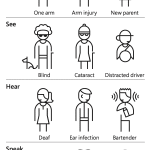Back in 2015 I wrote about the “perception of control“. These are situations where people don’t (or can’t) have control, but UI elements help make it look like they do. But lately I’ve been hearing about a dark UX pattern. This pattern, much like the UI patterns I noted, looks like a choice. But it isn’t.
There is a distinct ethical difference between the perception of control and the illusion of choice. Briefly, the perception of control is a UI pattern that allows for more flexibility. The illusion of choice is a dark UI pattern. It prevents a person from doing what they want or what is best for them.
The Perception of Control
There is a key element in the perception of control. The UI pattern helps the end user. Take an example from my 2015 article:
In Scenario A, the user opens the form, and the cursor automatically moves to the first field: Name. When he has finished typing his name, the cursor moves on to Date of Birth, and then Address. Farther down the form, the questions get more difficult, asking for long-form explanations. The user isn’t sure how he wants to phrase his response to “Reason for Applying,” so he tries to skip down to the next field. Unfortunately, the form has been hard-coded to prevent him from skipping fields, and he is unable to leave “Reason for Applying” until he has typed something into the field.
In Scenario B, the user opens the form, and the cursor again begins at the first field: Name. However, in this situation the user has full control, can fill out as many forms as he wants, and can submit the form at any time – with or without completing the fields. Incomplete fields will make the user less likely to be selected for the talent show, but it’s entirely up to him whether or not to complete the fields.
In Scenario C, the user opens the form, and is greeted by the perception of complete control: he can skip between fields at will. However, when he clicks “submit,” he will be greeted with an error message, reminding him that all fields must be filled in, in order to complete his application.
Most of us prefer Scenario C, which provides us the flexibility to move at our own pace and in the order we choose, while also ensuring we fill out all the fields that will impact our acceptance into the proverbial talent show.
The Perception of Choice, Amanda Pierce (UX Booth)
In other words, the perception of choice is a UI pattern to improve the experience.
The Illusion of Choice
On the other hand, here are some of the examples I’ve heard about the illusion of choice.
- Rate the App pop ups give people the option to rate the app. They can respond “now”, “later”, or “no thank you.” However, if you choose “no thank you” or “later” you get another request in 6-12hrs. There’s no option to say “don’t ask me again.”
- Microsoft’s “autoupdate” pop up has a similar pattern. Possible responses are “update” or “ask me later.” There is no option for “no”.
- Under Armour personalization asks if you want location-based content or “relevant and useful advertising”. Your choices are one, the other, or both. There is no option for neither.

Ethical UX Provides Options
What differentiates the illusion of choice from the perception of control? Quite simply, it’s the goal. The illusion of choice stops people from doing what they want or need to do, in favor of what the business might want. The perception of control help people do what they need to do, at their own pace or with some flexibility.
Ethically, UX designers need to keep an eye on what users need and want. Our goal should be there goal. Good businesses will align with this. Some business will struggle, and we’ll help them align. But dark patterns only emerge when businesses put their own goals (e.g. “rate the app”) over the user’s goals (“I don’t want to rate the app!”).
When in doubt, ask yourself what the user wants.


